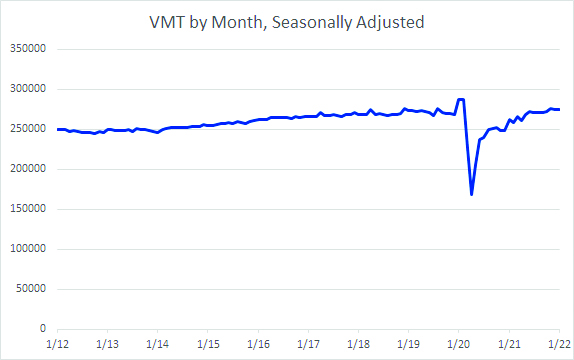Vehicle maintenance intervals are usually based on mileage or mileage and time interval. So when we have a significant shift in driving habits, such as when lockdown triggers a work-from-home trend, one of the many side effects may be a drop in demand for vehicle maintenance. In this article, we’ll look at public and private sources of vehicle miles traveled (VMT) estimates and look at trends.
Click here to read more
Where can I find VMT?
The primary government source for VMT is the Federal Highway Administration’s Office of Highway Policy Information, part of the United States Department of Transportation. You can find their reports at www.fhwa.dot.gov/policyinformation/travel_monitoring/tvt.cfm. They compile information that comes primarily from “approximately 5,000 continuous traffic count locations” compiled by the state. It usually takes six to seven weeks for a new monthly report. This means that the January totals were released in the third week of March.
If you are a member of the Auto Care Association, you may know of a private sector data source. In ACA’s TrendLens (https://trendlens.autocare.org/), you can subscribe to VMT data from Arity, which collects VMT data by tracking more than 23 million mobile devices. With Arity, you can get weekly as well as monthly reports, and with less time lag. Since Arity’s data is subscription-only, we’ll use public FHA data here.
What happened to VMT?
Since the initial March-April 2020 lockdown was eased, VMT has been recovering. The only problem is that it’s sometimes hard to tell by how much. Chart 1 shows VMT from January 2012 to January 2022, which at the time of this writing is the most recent data available. It is difficult to understand what is happening in this chart because VMT has a lot of seasonal variations. We can see this big dip, from the lockdown which started in March 2020, but there are plenty of other peaks and valleys.
In fact, it’s possible to see a trend – despite the lockdown year, there are steady declines still occurring in February, a short month with bad weather and little leisure travel. There are also regular highlights that last through the summer months when families hit the road for vacations. But all this seasonal movement, often referred to as “noise,” makes it hard to see the overall trend.
One way to ignore seasonal noise is to perform seasonal adjustments to the data. When the data is seasonally adjusted, you first try to estimate what these regular seasonal changes are. Once you have done this, you subtract these changes from the raw data to produce the “seasonally adjusted data”. The US Department of Transportation statisticians did it for us.
The seasonally adjusted data can be found in Chart 2. You still see the sharp drop due to the lockdown, but otherwise you see the smooth and slow recovery in VMT, although not quite back to pre-pandemic levels.

Making seasonal adjustments requires some statistical training. There is another quick and dirty way to do this that is much easier. This is an “apples to apples” approach, but it might be more accurate to call it a “January to January” approach. Here you would simply compare the January numbers to all previous Januarys, then in February you would look at the new monthly numbers and compare them to all previous Februarys.

Chart 3 takes the data for the most recent month, January, and compares it to other January months dating back to the year 2000. It shows that January 2022 was much stronger than January 2021, but is still much lower than the pre-pandemic month of January 2019. or 2020.
What else affects VMT?
VMT’s changes are influenced by more than just changes to “work from home” and other lockdown policies. Another factor that will affect the kilometers traveled by vehicles is the price of gasoline. Chart 4 shows the weekly gasoline price in the United States. Specifically, these are retail gasoline prices for all formulations and grades in the United States, and it is calculated by the US Energy Information Administration, which is part of the US Department of Energy. Due to magazine production delays, this chart displays data through March 29. https://www.eia.gov/petroleum/weekly/.
Even though the big price spike triggered by the Russian-Ukrainian war got the most attention, gas prices have been rising since the beginning of 2021, at the same time as the VMT has rebounded, as you can see on the graph 4.

Do the laws of supply and demand have no effect? In the short term, large jumps in gas prices lead to only small changes in driver behavior. Some discretionary rides may be canceled, but you will continue to commute to work, groceries, and other scheduled rides. If you were already planning to spend $2,000 on a Florida road trip over spring break, you’re still going to do it even though gas will cost $100 or $200 more. It’s only in the long term, when people are convinced that the new gas price levels are permanent, that you’ll start to see big changes in behavior – like trading in an SUV for a smaller car, get closer to work, engage in public transport, etc.